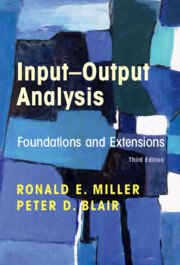Book contents
- Input–Output Analysis
- Input–Output Analysis
- Copyright page
- Contents
- Figures
- Tables
- Preface
- 1 Introduction and Overview
- 2 Foundations of Input–Output Analysis
- 3 Input–Output Models at the Regional Level
- 4 Organization of Basic Data for Input–Output Models
- 5 The Commodity-by-Industry Approach in Input–Output Models
- 6 Multipliers in the Input–Output Model
- 7 Supply-Side Models, Linkages, and Important Coefficients
- 8 Decomposition Approaches
- 9 Nonsurvey and Partial-Survey Methods:
- 10 Nonsurvey and Partial-Survey Methods:
- 11 Social Accounting Matrices
- 12 Energy Input–Output Analysis
- 13 Environmental Input–Output Analysis
- 14 Mixed and Dynamic Models
- 15 Additional Topics
- Postscript
- Book part
- Author Index
- Subject Index
- References
3 - Input–Output Models at the Regional Level
Published online by Cambridge University Press: 06 January 2022
- Input–Output Analysis
- Input–Output Analysis
- Copyright page
- Contents
- Figures
- Tables
- Preface
- 1 Introduction and Overview
- 2 Foundations of Input–Output Analysis
- 3 Input–Output Models at the Regional Level
- 4 Organization of Basic Data for Input–Output Models
- 5 The Commodity-by-Industry Approach in Input–Output Models
- 6 Multipliers in the Input–Output Model
- 7 Supply-Side Models, Linkages, and Important Coefficients
- 8 Decomposition Approaches
- 9 Nonsurvey and Partial-Survey Methods:
- 10 Nonsurvey and Partial-Survey Methods:
- 11 Social Accounting Matrices
- 12 Energy Input–Output Analysis
- 13 Environmental Input–Output Analysis
- 14 Mixed and Dynamic Models
- 15 Additional Topics
- Postscript
- Book part
- Author Index
- Subject Index
- References
Summary
Chapter 3 extends the basic input–output framework to analysis of regions and the relationships between regions. First, “single-region” models are presented and the various assumptions employed in formulating regional models versus national models are explored. Next, the structure of an interregional input–output (IRIO) model, designed to expand the basic input–output framework to capture transactions between industrial sectors in regions, is presented. An important simplification of the IRIO model designed to deal with the most common of data limitations in constructing such models is known as the multiregional input–output (MRIO) model. The basic MRIO formulation is presented and the implications of the simplifying assumptions explored as well as the balanced regional model which captures the distinction between industrial production for regional versus national markets. Finally, the chapter summarizes the fast-growing range of applications of MRIO to multinational and global economic models and issues.
Keywords
- Type
- Chapter
- Information
- Input-Output AnalysisFoundations and Extensions, pp. 63 - 111Publisher: Cambridge University PressPrint publication year: 2022



